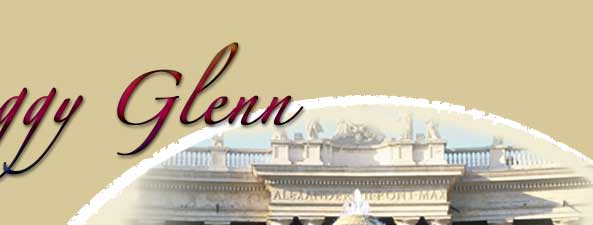|
|
|
Florence |
|
The train trip from Rome to Florence was gorgeous! Firenze is the Italian name, and it was founded in 57 B.C.
Florence is in the Tuscany Region and we saw vineyards, corn, wheat and sunflower fields. The sunflowers were bright yellow, so it was like looking at a sea of yellow. Very pretty! But, as we found normal, the train windows were too dirty to take good pictures
One of the best things about Florence was the light sprinkling of rain! After Venice and Rome anything under 95 degrees was welcomed!
|
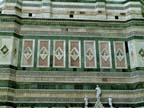 |
Once we arrived in Florence we headed straight for the Piazza San Giovanni, which is where the Baptistery of St. Paul and The Cathedral of Santa Maria del Fiore ( the Duomo) is located.
Both of these building are faced in the most beautiful marble: Carrara white, Prato green and Maremma rose.
|
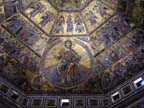 |
The Baptistery of St. Paul was built around the 4th or 5th century. It is in the shape of an octagon. The eight sides stand for the eighth day of the week which is the day of the Christian's hope for a resurrection of the dead. The cupola (dome) is stunning with 13th century mosaics.
|
 |
Christ is the center attraction and he is topped by a choir of Angels. Under his feet, the dead are rising from their sepulchers. They represent the Last Judgement, when the risen Lord will summon living and dead alike to account for their actions. Looking down on the left are the souls of the righteous "in the bosoms" of Abraham, Isaac and Jacob, the Patriarchs of ancient Israel. To the right is Hell.
|
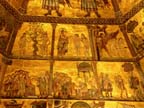 |
The remaining sectors of the dome are horizontal tiers of mosaics which tell the stories of Saint John the Baptist, Christ, the Patriarch Joseph, and the beginnings of human life (Adam and Eve, Cain and Abel, Noah and his family).
|
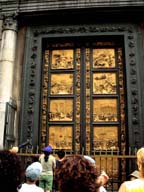 |
On the outside there are three sets of bronze doors. One created in the 1330's with scenes of the life of St John the Baptist, one created in 1440, with scenes from the New Testament, and the most famous, created in 1425, is the Gates of Paradise (as Michelangelo called them) with scenes from the Old Testament
|
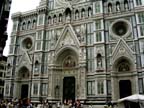 |
The Cathedral of Santa Maria del Fiore is called the Duomo – the house of God and his people. It was started in 1296 over and around the existing Cathedral Santa Reparata which was built in the 4th and 5th centuries on the ruins of a Roman house.
Santa Reparata was not only falling apart, (even though it had been rebuilt in the 9th century) it was no longer large enough to serve the growing city. In 1295 with a vote by all the citizens the plans for the Cathedral of Santa Maria del Fiore were started.
|
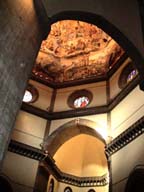 |
The Cathedral of Santa Maria del Fiore took 140 years to build, which is not all that long. The building was interrupted by social situations and natural calamities (the economic crises due to the crash of the Bardi and Peruzzu banks, and the flood of 1333, the popular uprisings and the plague of 1348). |
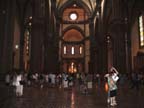 |
The inside is very large and very sparse. Because it was built with public funds as a "state church" and had a civic program honoring illustrious men the lower walls are primarily blank.
|
 |
The upper walls contain 44 windows with the most extensive stained glass program in the 14th and 15th century Italy. The windows depict Old and New Testament saints and scenes from the life of Christ and Mary.

|
|
The Dome (Cupola) |
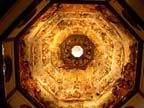 |
The dome was painted between 1572 and 1579 by Giorgio Vasari and Federico Zuccari. The theme is the same as in the Baptistery: the Last Judgement.
|
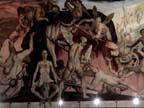 |
Their view of Heaven and Hell is a little more graphic than in the Baptistery, to say the least.
|
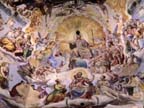 |
After waiting in line for 45 minutes we had the pleasure of climbing over 420 steps to see the inside of the cupola. It was worth the climb for the pictures, but my calves were starting to hate me.
|
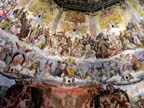 |
We choose not to climb another 200 steps in order to go on the outside as there was a huge backlog of people on the stairs, and the previous stairs are very narrow, steep and in places very small circular steps. Plus, we only had 30 minutes before closing time. So we opted to take pictures of the city from some of the upper windows in the stairway, as well as the inside of the cupola. |
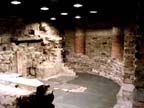 |
Excavations of Santa Reparata
A modern staircase at the back of the cathedral takes you down to the excavations of the old cathedral Santa Reparata and of the Roman house Santa Reparata was built on top of. The excavations are sparse compared to the excavations we saw in Barcelona, but they were still worth the $1.50 entrance fee.
|
|
Galleria dell’ Academia
This gallery houses an extremely important collection of sculptures by Michelangelo. with David being one of the most well known. When Jim and I visited the gallery in 1999 I was able to take all the pictures I wanted. There were no cameras allowed on this visit. This was ok for David as now there is a 5 foot high wooden barrier around the pedestal and due to the restoration work, there are wires running in back of David with moisture and humidity sensors hanging from them. In 1999 we were allowed within 3 feet of the sculpture and I took a ton of pictures. The wooden barrier now keeps one further away.
Either in September or November I will do a page with my pictures from 1999, as there are some great sculptures in addition to David, plus some wonderful paintings.
|
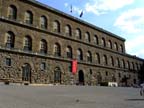 |
Palazzo Pitti
Palazzo Pitti is one of the cities most imposing palaces and was built around 1457. In the 16th century the Medicis (a famous banking family) had it enlarged.
The front of the palace is very plain. It is composed of rusticated ashlars with some blocks being over 6 feet long.
|
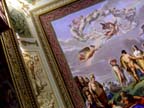
This is all paint!
The tapestry ceiling and the marble sculpture border.
|
This was another place where in 1999 I was allowed to take pictures but not this time. I was only able to get a few of the ceilings. The ceilings and borders of all the rooms were amazing. They were painted to look like sculptures or tapestries.
|
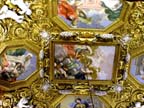 |
Some ceilings were painted and then plaster and real sculptures were added.
|
|
Inside the palace are numerous galleries. Most have at least 36 to 43 paintings hanging from the walls, with at least 6 in each room that are 9 by 12 feet! It was typical in the 17th century to display your collection that way. The only thing is there are at least 20 rooms of paintings.
|
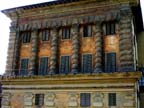 |
Sharon and I saw some rooms that were closed during my 1999 visit: two state rooms and a private audience chamber. All of these rooms were painted by two artists, Agostino Mitelli and Angelo Michele Colonna between 1638 and 1641. All three rooms are painted to look the walls had sculptured arches, sculptured figures, stairways, balconies and amazing paintings on the wall.
They really do appear three dimensional.
We also saw rooms of treasures. The most intricate ivory carvings of all sizes. Some were over 2 feet high, some where only inches high. There is no telling how many elephants gave their lives for this. In one case alone, I figured 10 as there were 20 large pieces. But the pieces were of amazing artistry.
|
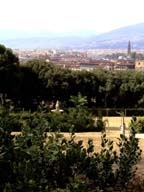 |
The Bobali Garden , in back of the palace is the largest monumental green space in Florence.. It is not formally manicured, but consists of large fields, woods, trails, a coy fish pond and a nice miniature rose garden. The garden dates back to 1549. There are also several wonderful views of Florence from this area.
|
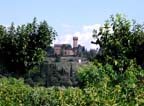
A castle as seen from the garden.
|
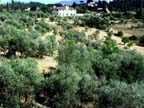 |
|
|
|
|
|
|
|
|
|
|

